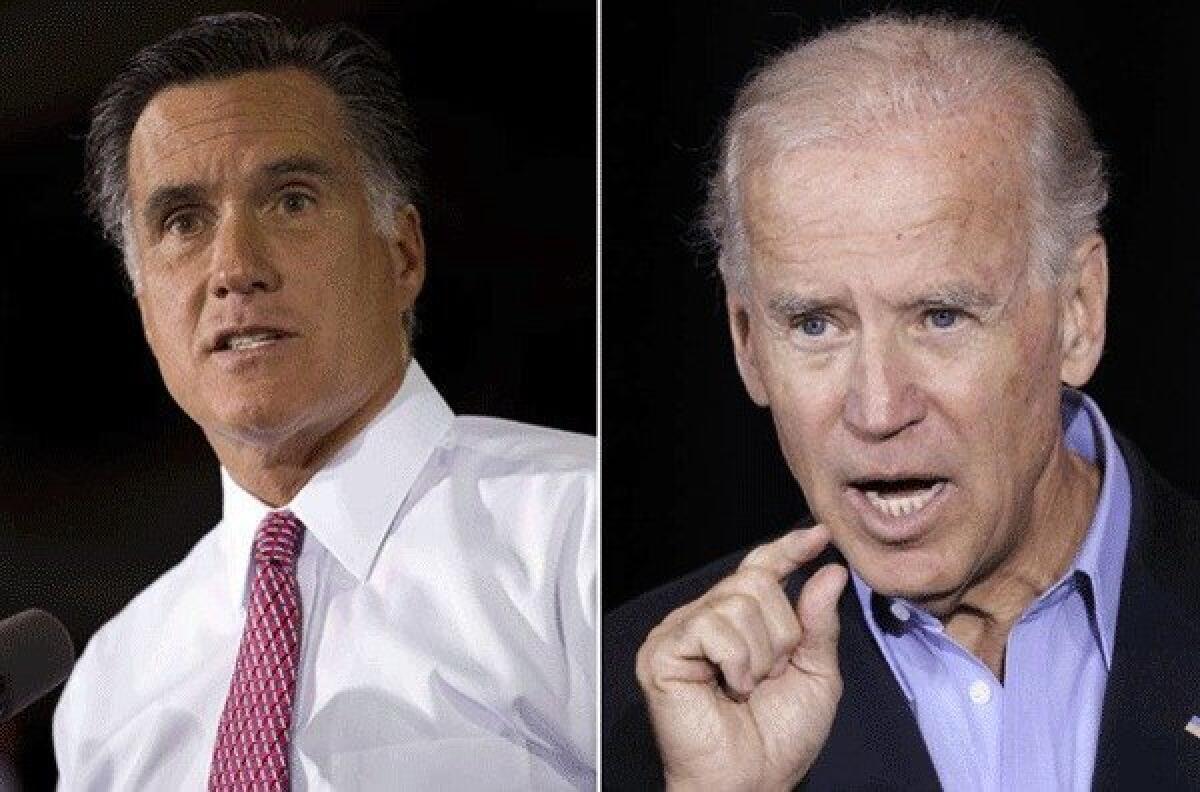A Romney-Biden White House? It could happen

“Congress to pick the president.” — headline, Nov. 7, 2012.
Sound ridiculous? Daft? Not at all.
The magic number is 270 — electoral college votes that is — to win the big prize. According to 270towin.com, there are now 11 “battleground” states and, statistically, 32 permutations from these up-for-grab states that could produce a 269-vote electoral college tie in the presidential election.
ENDORSEMENTS: The Times’ recommendations for Nov. 6
Based on the site’s simulated polls, the mathematical probability of a tie increased almost fourfold in recent weeks — from 0.3% to 1.1%. And both political camps concede the race is tightening each day. Is there more gridlock ahead? It’s a small but scary possibility.
So what if one of these 32 combos comes to pass? No, unlike Gore vs. Bush in 2000, the issue doesn’t go to the Supreme Court for resolution, at least not right away. It turns out the Constitution has a nifty, two-step solution.
First, the 435 House members convene to elect the president. But only 50 votes are cast, one per state, so the delegates from each state first vote to determine how their state will cast its one vote. The current House GOP majority (240 to 190) has Romney likely getting the nod. But that could quickly change because it’s the newly elected House that casts the critical vote.
SLIDESHOW: Six numbers to ignore from the presidential campaign
Next, the 100 senators convene to elect the vice president. The current Senate makeup favors the Democrats 51 to 47, with two independents, so Joe Biden would keep his No. 2 gig. Again, that razor-thin margin could move on election day.
And if there’s a tie vote in either the Senate or House? We’ll get to that.
Instinctively, a 269-vote tie would be an urgent call to action to amend the Constitution to scrap the archaic procedure and stipulate that a simple majority of the total popular vote takes the prize. Surely we’ll never get a tie with 132 million or so votes being cast.
COMMENTARY AND ANALYSIS: Obama vs. Romney
But there are a few more bumps on this presidential road.
Could electors cast their vote for someone other than the popular vote winner in their state? Twenty-six states have feckless laws prohibiting that, and in most states, it doesn’t usually happen. Yet there are always the “faithless” electors — those who flip their vote. It has happened 156 times in our history, though about half of those were votes involving candidates who died between the election and the electoral college vote. But 82 votes did involve a change of allegiance. And it has been reported that three GOP electors who support libertarian Ron Paul are making noise about refusing to vote for Mitt Romney. Remember, it may take only one switcheroo.
Let’s assume the college affirms the 269-tie vote so the gridlocked issue moves to Congress. In the House, what happens if the states deadlock at 25-25? The vice president takes charge as acting president until the House breaks the stalemate. But wait, that’s true only if the veep “qualifies,” which Biden wouldn’t until the Senate elects him. So the House speaker — currently John A. Boehner (R-Ohio) — would serve as acting president. But wait again. Boehner is required to resign as both speaker and House member to serve in his new role, something he may not fancy. If Boehner declines to serve, the acting president gig defaults to none other than the venerable Sen. Daniel K. Inouye (D-Hawaii), the 88-year-old Senate president pro tempore.
Then there is the tricky political dynamic of House members’ loyalties to their party versus their constituents. It often happens that a House member wins the congressional election but the same district goes for the other party’s presidential candidate. The conundrum for the House member: Should party loyalty trump a clear electoral mandate of the district’s voters, and, by the by, how will my shameless partisanship affect my reelection in two years?
In the Senate, the Constitution generally provides that a 50-50 vote allows the vice president in his capacity as president of the Senate to break the stalemate. That means Joe Biden would vote for Joe Biden and, voila, elect Joe Biden — surely a troublesome result. The better procedure is the one described above for the House: Boehner or Inouye take charge until the Senate gerrymanders 51 votes for a vice president.
And speaking of gerrymandering, for the House or the Senate to cast a tie-breaking vote for either president or vice president, the Constitution stipulates a two-thirds quorum requirement. What happens if the putative losing party (likely Democrats in the House, the GOP in the Senate) decides to go AWOL? Recall just last year the Democratic caucuses in Wisconsin and Indiana high-tailed it across their respective state lines for weeks, successfully thwarting a legislative quorum on controversial anti-union legislation. The political shenanigans in our nation’s capitol during a lawmakers’ exodus would be breathtaking.
If the hanging, dimpled and pregnant chads in Bush vs. Gore made you scoff, then just wait until the Supreme Court tackles the election of the odd couple — Mitt and Joe. Or maybe Barack and Paul.
But wait one final time. What’s wrong with a White House served by both parties? Isn’t it time for our politicians to lead by example and kick-start genuine bipartisanship right from the top?
John Klotsche is a retired partner and former chairman of a Chicago-based international law firm. He is now a writer in Santa Barbara.
More to Read
A cure for the common opinion
Get thought-provoking perspectives with our weekly newsletter.
You may occasionally receive promotional content from the Los Angeles Times.










